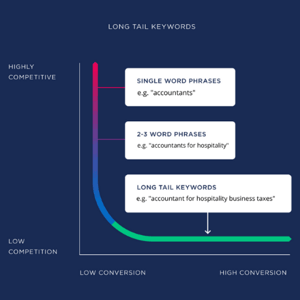2 min read
The Revolutionizing Video Marketing - What's Trendy
In the ever-evolving world of digital marketing, staying ahead of the curve is paramount. This article delves into the transformative trends shaping...
4 min read
Markezing Team : Oct 14, 2021 10:00:00 AM

You probably already know that it’s important to rank high on Google and other search engine’s organic results pages. You probably already know how to do it too — the answer of course is to have a strong content marketing strategy with on-page SEO and fresh SEO optimised content.
But are you including longtail keywords in your planning and content strategy?
In this article, we’ll guide you through longtail keywords; what longtail keywords are, why they’re important and how to find them. They’re important because the vast majority of Internet searches are longtail searches.
By the end of the article, you’ll know the importance of adding them to your SEO strategy and advertising campaigns.
Longtail keywords are low volume, high intent searches that are usually longer and more descriptive than short tail keywords. In an accounting example, someone looking for a new accountant might search ‘accountants’. That’s a short tail keyword. If they were more specific and searched ‘accountants for tax preparation’ or ‘accountants for hospitality businesses’ that would be a longtail keyword.

Longtail keywords also have a great deal of variation because the searches are very specific or because the search query can be phrased in many ways. Using the above accountant example again, other similar longtail searches could be ‘accountant for end of financial year’, ‘accountant for tax time’, ‘accountant for hospitality business taxes’.
The benefit of including them in your content strategy and advertising campaigns is enormous because competition is so low (most of your competitors will be going after the high-volume short tail keywords) and intent is high.
Let’s look at how to find relevant longtail keywords.
Finding longtail keywords is almost identical to finding all your keywords. This time though, you’re looking for words and phrases that have low volumes. Here’s a step-by-step guide:
Google Auto Complete: This is the quickest and easiest way to find longtail keywords. Simply take the broad topic that your services relate to and check Google’s suggestions. The ‘people also ask’ and ‘searches related to’ boxes will also give you a good guide as to how people search for services like yours.
Ahrefs, SEM Rush and Moz: All three of these tools (and others) will help you find relevant keywords to target without the manual and repetitive work the Google method above takes. To find the right keywords, simply enter a seed phrase and filter by lowest volume or word count to find longtail keywords. Most tools will also allow you to see ‘questions’ being asked, for example, ‘how to choose an accountant’.
Answer the Public: Answer the Public is a fantastic social listening tool that gives you raw insights on how people are searching for your topics or services. In addition to search engines, Answer the Public canvasses social media and forums, however there’s no search volume, so it’s not easy to know if some phrases are worth targeting.
Customer Interviews: You probably did this when you completed your buyer personas, but why not do it again and find out how your customers found you and which search terms they used when they found you.

When you’ve found the longtail keywords that you want to target for it’s time to start building a strategy that gets you ranked. But it’s not about keyword stuffing, your content strategy around these keywords needs to be thoughtful, deliberate and sustained.
That means producing valuable, evergreen content that responds to the longtail search term and helps you build trust with your audience. The best way to create high-ranking, high-engagement content with longtail keywords in mind is to find the hero topic that the longtail keyword relates to.
For example, the search ‘which entertainment expenses can I claim?’, relates to the topic ‘deductible business expenses’, so you need to create content around the hero topic and integrate the related longtail phrases (all of them) into the content.
To rank well, you need to write a better content piece than the sites that are currently ranking well for the longtail phrase and the broad topic.
To write a better ranking piece of content you need:
Length: We recommend 2,000 – 2,500 words
Links: Make sure you include between 5-10 internal links to your existing content (both blogs and pillar pages) and backlinks from high authority websites (use any of the tools above to check the domain authority of a website).
Longtail Headlines: When you’re planning your article, use the longtail keywords you’ve identified to form the article outline and try and incorporate the relevant keywords in your headlines.
Images: Content needs to be visually appealing, so be sure to include images, illustrations, screenshots, or other visual descriptions which support your copy.
Not only can longtail keywords be used in your permanent content strategy, but they can also be used in advertising strategy — provided you can find enough longtail keywords with enough volume to make it through Google’s volume threshold. Remember that most of the world’s searches are longtail searches and most of your competitors will be targeting high volume, short tail keywords. That means you’ll be getting cheap traffic that your competitors have ignored.
It’s worth it because the search traffic is so specific that it demonstrates more intent than broad topic searches. Someone looking for an ‘accountant’ might be comparing several local accountants or even looking for a job, but someone looking for a ‘tax accountant for software companies’ is clearly looking for accountant with a specific set of skills.
Follow the same steps above to find the longtail keywords that you want to serve ads alongside and add them to your Google Ads campaign. The difficulty here is finding a destination URL that is relevant to all of them and writing an ad that speaks to all the different longtail keywords.
Here are a few tips for writing ad copy that covers many different longtail keyword:
Group your keywords into topics. If your longtail keywords are about ‘claiming expenses’, ‘deductibility’, ‘can I deduct home office expenses’, ‘claiming entertainment expenses’ and so on, write an ad that covers the broad topic such as ‘Get all your business expenses questions answered’.
Link all longtail keywords by pain point. For example, if someone is searching for ‘how to calculate gross margin on my products’ we can assume that they are a business owner of a product-based business, therefore we can go after all inventory and margin calculation search phrases and group them in an ad such as ‘accountants that understand inventory, margins and product pricing’.
Test and optimise regularly to ensure you’re getting the right traffic, managing your costs and delivering ROI. If necessary, remove keywords as necessary and continually look for additional opportunities.
The short answer is yes. Longtail keywords give you an opportunity to target low cost and low competition keywords, which means you’re likely to see an improvement to your search rankings and organic traffic.
However, as much as we believe that this is a viable and sensible marketing tactic, we believe you should have your high-volume SEO and content strategy in place before you attempt to leverage longtail keywords.
If you need help with either, book a call with us today for a no-obligation chat about your content, SEO, and ad campaigns.

2 min read
In the ever-evolving world of digital marketing, staying ahead of the curve is paramount. This article delves into the transformative trends shaping...

2 min read
In today's fast-paced business landscape, social selling has become a powerful strategy to connect with potential customers and drive revenue growth....

4 min read
E-commerce is growing rapidly, and recent research estimates that it will make up over 22% of global retail sales by 2023. With these statistics and...